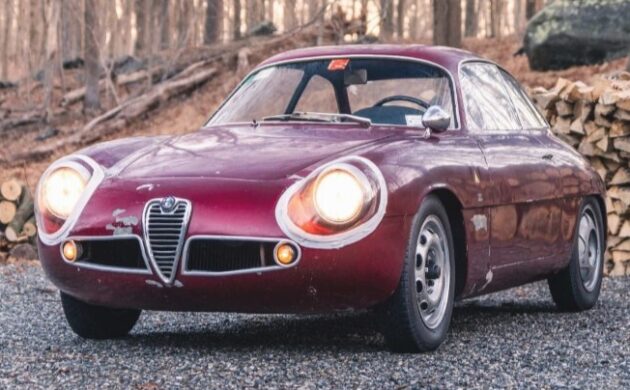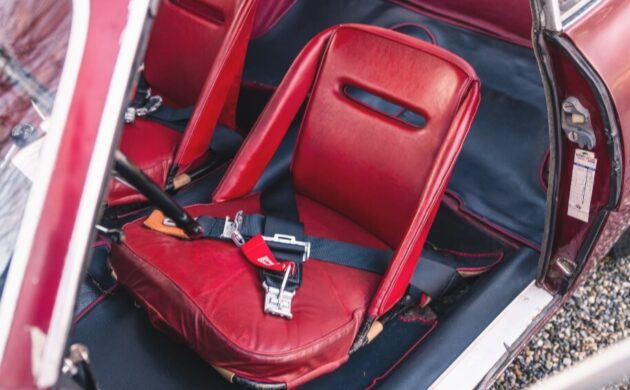In 1956, a privateer crashed his Giulietta Sprint Veloce while racing the Mille Miglia. He promptly shipped the car to coachbuilder Zagato for a patch job, but what emerged instead was an aerodynamic alloy body with plexiglas windows that proved faster than the original. After a few more were made for other racers, Alfa contracted with Zagato to put the little car into production on the Giulietta Sprint Veloce chassis. The 1290 cc motor was tuned to within an inch of its life, and the cars amassed worthy race records. Here at Kidston is a 1960 Alfa Romeo Giulietta SZ (sport Zagato) for sale, chassis number 00043. As is typical with Kidston, no price is listed, but we will explore that in a minute. Thanks to Araknid78, who keeps Barn Finds writing about the occasional exotic!
The jewel of an engine is an alloy block, five main bearing, double overhead cam in-line four-cylinder, with a double-row timing chain, alloy head, and hemispherical combustion chambers. This motor in Zagato trim sports two Webers and 100 hp. Top speed is over 120 mph. Kidston advises that the block was changed out in the car’s early years, and a spare block comes with the sale. A five-speed manual and finned aluminum drum brakes round out the mechanical specs.
The interior is a study in devotion to racing, with a minimum of comfort, liberal use of aluminum, and just three gauges – the spareness contributing to the car’s bare 1900 lbs. While the minimal weight and aerodynamic body of the SZ made it quick, another racing accident contributed to a second transformation of the Giulietta: in 1961, Francesco De Leonibus pushed his SZ to an unheard-of 137 mph. That car had also been rebuilt after an accident, but by Michelotti, and its new body was slightly elongated. Back to the drawing board, Zagato went. The result was a longer, Kamm-tail version of the SZ, known as the Coda Tronca (truncated tail). Only thirty of this second series were made.
Chassis 00043 was originally painted silver with a red interior. In 1963, the then-owner changed the exterior color to a dark red and it began racing with a set of steel/alloy wheels in the rear and steel wheels in the front which it retains to this day. In fact, from the time of its last race – the Targa Florio in May 1963 – to now, it remains cosmetically unchanged. Kidston presents a full chain of ownership, including notes on a mechanical refresh completed in 2022 under its current owner who purchased the car in 2018. Records show that chassis 000043 was sold at Gooding’s Scottsdale auction in 2015 for $577,500. A similar car, but restored, sold at Artcurial in mid-2022 for €417,200. Others have been offered in the $500k to $600k range recently but failed to find new homes. Should this example receive a premium for its originality, or not? What do you think?








100 HP from a naturally aspirated 1.3L motor-in the late ‘50’s.
Amazing engineering.
Insofar as paying extra for originality: were someone to buy it and continue to race it I could see that the premium would add to the flavor. When the owner/driver talks about the dings and dents as to what caused them and where, it would make for some fascinating history of the car and racing itself.
Personally I’d love to hear it at speed-if that quintessential banshee scream doesn’t stir the blood, the listener is lifeless.
I’m saving as many of the old scars as I can on the car I’m racing next month. I bought it in 98 and it has a tire burn on the passenger door from the early 80s. I think the paint is original from the 70s.
Alfa Romeo and Zagato have partnered together several times over the years. I would say all the Zagato bodied cars are special if not controversial to some. I really like the Junior Zagato which was equally rare but significantly more affordable. If Gordon Murry owns one it’s good enough for me.
https://www.mecum.com/lots/AZ0321-453369/1973-alfa-romeo-1600-junior-zagato-coupe/
Good looking car. They sure got the aerodynamics right considering it was before spoilers, air dams, etc.
As we all know they are only all original once.
Out of my price range but still very cool.
I love that there is an old school oil change sticker in the driver’s door jamb. It’s hard to believe that anyone ever let the kid down at Joe’s Shell (corner of Main and First) touch this car. It doesn’t seem as if this was ever just an old car.
WOW any car from Alfa is next but if it has been rebooted from Zagato then it automatically falls into the range of a work of art. For those too young to know that statement of work of art includes the drum brakes on this era of Alfa. Cast finned aluminum with a steel sleeve as the braking surface. In almost every instance you could never get the brakes hot enough to fade. The only improvement that disk brakes got you was that they were cheaper to make and had less unsprung weight.
Not a daily driver but an amazing thing to see here.
There is an originality premium. And then the Kidston premium.
It woúld be rude to haggle….
What a car!
Bumpers were not required on overseas cars in the early 1960s?!
Its been repainted at least once. Now its all just old. At the level this car runs with, original condition cars fetch a premium when in nice condition. Beat up and old not so much. except maybe in the UK. They seem to really like their crumbling rusty Aston Martins
I once restored the first Cobra delivered to the west coast . Ca # CSXOO12, the damage was left rear quarter and fender. Owner had us repaint the whole car including the roll bar which had a tech sticker from the last day at Riverside!!! It had exactly 40k race miles on the odometer and had never been registered for the street til then. If it was up to me I would have just spotted the repair and took it home.
Awesome car nevertheless!